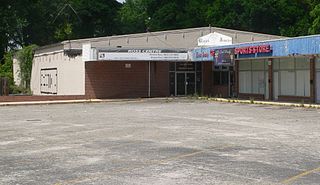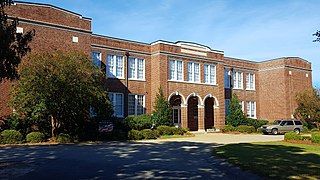
All-Star Triangle Bowl is a former bowling alley located in Orangeburg, South Carolina, United States. The lanes are a historic fixture of the community. The original owner was Harry K. Floyd. All-Star Triangle Bowl is most known for its fundamental role in the Orangeburg Massacre, which was sparked as a result of Floyd refusing to allow people of color to bowl at the privately owned bowling alley. He owned and operated the alley until his death on July 12, 2002, following which his son, Harry K. Floyd, Jr., took over.

Camden station, also known as the Seaboard Air Line Railroad Depot, is a train station in Camden, South Carolina. It serves Amtrak, the national passenger rail service. The station was built by the Seaboard Air Line Railroad in 1937. It is located on 1100 West DeKalb Street, although some sources give the address as being at 1060 West DeKalb Street. Either way, it was named to the National Register of Historic Places in 2000. The station is in disrepair, and a renovation project is scheduled to commence in August 2014. The station renovations were completed in early 2016.

Southern Railway Passenger Station is railway passenger depot built ca. 1885 in Westminster, South Carolina. It is one of the oldest buildings in the community.

Pinewood Depot is an historic railway station located at the junction of East Avenue and Clarke Street in the town of Pinewood, at the southern entrance of the High Hills of Santee, South Carolina. It is the only railroad station left in Sumter County, but is not longer used by CSX, the current owner of the railroad right-of-way. On June 10, 1997, it was added to the National Register of Historic Places.

Atlantic Coast Line Railroad Depot is a historic train station located at Conway in Horry County, South Carolina. It was built in 1928 by the Atlantic Coast Line Railroad, and is a long, rectangular, one-story, gable-roofed, frame board-and-batten building. It features the wide overhanging eaves and is in the American Craftsman style.

Myrtle Beach Atlantic Coast Line Railroad Depot is a historic train station located at Myrtle Beach in Horry County, South Carolina. It was built in 1937 by the Atlantic Coast Line Railroad, and is one-story rectangular building was constructed with the standard ACL bi-level floor plan that has a raised freight room with steps leading down to the lobby/office area. It features exterior architectural detailing reflecting Colonial Revival, Craftsman, and Mission stylistic influences.

Mt. Pisgah Baptist Church is a historic Baptist church building at 310 Green in Orangeburg in Orangeburg County, South Carolina. It was built in 1903, and is a one-story, brick Romanesque Revival-style church building. It features a prominent corner tower.

Trinity Methodist Episcopal Church is a historic Methodist Episcopal church located at 185 Boulevard NE in Orangeburg, Orangeburg County, South Carolina. It was built between 1928 and 1944 and is a two-story, brick Late Gothic Revival-style church building on a raised basement. It features a large Tudor arched stained glass window with molded cast stone surround.

White House United Methodist Church, also known as the White Meeting House and White Church, is a historic Methodist church located near Orangeburg in Orangeburg County, South Carolina. It was built about 1850, and is a one-story, rectangular frame meeting house style building. It houses the oldest Methodist congregation in Orangeburg County, dating back to the late 1780s. Francis Asbury visited the congregation in 1801 and 1803.

Williams Chapel A.M.E. Church is a historic African Methodist Episcopal church located at 1198 Glover Street in Orangeburg, Orangeburg County, South Carolina. It was built between 1915 and 1925, and is a one-story, brick Gothic Revival-style church building on a raised basement. It features two towers on the facade with pyramidal roofs and Gothic arched stained glass windows.
The Charlotte and South Carolina Railroad began in 1852 and operated until 1869, when it was absorbed by Charlotte, Columbia and Augusta Railroad. The line ran between Charlotte, North Carolina and Columbia, South Carolina. It was the first carrier to serve Mecklenburg County, North Carolina. The railroad was 110 miles (180 km) long and its track gauge was 5 ft.
The Northeastern Railroad was a 103-mile (166 km) 5 ft gauge railroad that served South Carolina in the second half of the 19th century.

The Manchester and Augusta Railroad was a Southeastern railroad that operated following the American Civil War. The Manchester and Augusta Railroad was chartered in the 1870s, and built a line from Sumter, South Carolina, southwest to Denmark, South Carolina.

Edward Culliatt Jones was an American architect from Charleston, South Carolina. A number of his works are listed on the U.S. National Register of Historic Places, and two are further designated as U.S. National Historic Landmarks. His works include the following :

Numertia Plantation is an historic plantation house located near Eutawville, Orangeburg County, South Carolina. It was built about 1850–1851, probably for Major Samuel Porcher. It is a two-story frame structure on a brick foundation. The house follows the pattern of central hall farmhouses, two rooms deep and two rooms wide.

Southern Railway Passenger Depot, also known as Branchville Depot, is a historic train station located at Branchville, Orangeburg County, South Carolina. It was built in 1877 by the Southern Railway. It is a one-story, brick building with a stucco finish and hipped roof. It was the site of a speech given by President-elect William Howard Taft in 1909.

Springfield High School is a historic high school complex located at Springfield, Orangeburg County, South Carolina. It was built in 1928–1929, and is a two-story, brick high school building with a projecting central and end pavilions. Also on the property are the contributing gymnasium building (1938) and Springfield Graded School Annex.

Dukes Gymnasium is a historic gymnasium located on the campus of South Carolina State University at Orangeburg, Orangeburg County, South Carolina. It was built in 1931, and is a two-story, brick building with a full basement and a gable on hip roof. The front façade features a five-bay brick arcade. It is the home venue for the South Carolina State Bulldogs women's volleyball team. Intramural Men's Basketball Scoring Record is held by Antonio D. Coleman. Coleman scored 63 points in the semifinals overtime lost to SC/GA Connect. The game ended on a last second buzzer beater three pointer from Kevin Mack. The game has been heralded as one of the greatest games to be played Dukes Gymnasium ever.

Union Station, also known as Atlantic Coast Line Railroad and Southern Railway Station, is a historic train station located at Columbia, South Carolina. It was built in 1902, and is a brick and stone, eclectic Jacobethan Revival / Tudor Revival building. It features stepped gables and towering chimneys. It was designed by architect Frank Pierce Milburn for the Atlantic Coast Line Railroad and Southern Railway. In contrast to the custom of 'union station' denoting the single station for several railroads, the Seaboard Air Line Railroad had its own station one-half mile away. The formerly Seaboard Silver Star still operates through another station in Columbia.
The Orangeburg Subdivision is a railroad line owned by CSX Transportation in the U.S. state of South Carolina. The line runs from Sumter, South Carolina, to Cope, South Carolina along the former Manchester and Augusta Railroad line, for a total of 53.8 miles (86.6 km). At its north end the line continues south from the Eastover Subdivision and at its south end the line continues south into the SCE&G Power Plant Trackage.



























